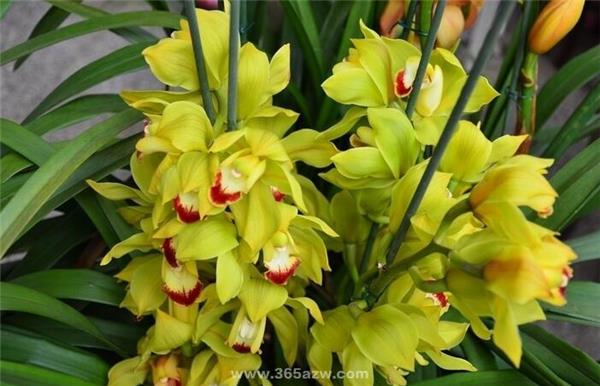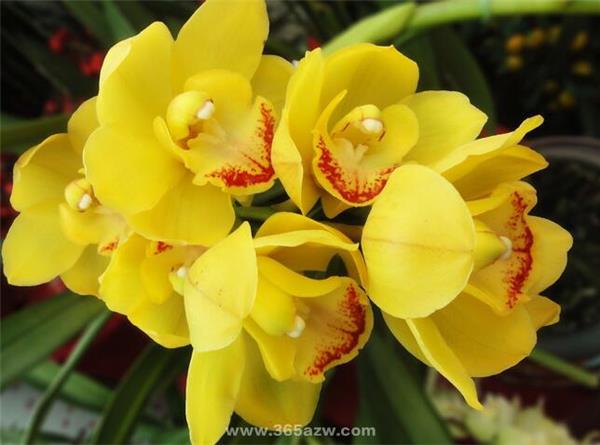Culture methods and matters needing attention of Cymbidium
Cymbidium is a potted ornamental plant. Cymbidium is prone to leaf spot disease. What are the breeding methods and points for attention of Cymbidium?

Culture methods of Cymbidium:
1. Propagation: the method of ramet reproduction is often used, and the time of dividing plant is longer than that after flowering, and before the new bud grows, it is carried out during this short dormant period. It should be properly dried before ramet and operated when the roots are slightly whitish and soft. Those with strong growth usually split once in 2-3 years, and each clump of orchid seedlings should have 2-3 pseudobulbs, one of which must be newly formed in the previous year.
2. Temperature: it likes strong light, and the suitable temperature for growth is 10 ℃ ~ 25 ℃. It should be cultured in a greenhouse with low temperature in winter.
3, humidity: it likes to be wet very much, but it should pay attention to ventilation, otherwise it is easy to get anthracnose, the humidity of small seedlings should be 80%, and the humidity of medium and large seedlings should be 60% to 85%.
4. Fertilization: the ratio of nitrogen, phosphorus and potassium is 1:1:1 in the growing period, 1:2:2 to 3 in the flowering stage, and the pH value of the fertilizer solution is 5.86.2.
5. Watering: sprinkler irrigation is usually used in production, once a day in May and September, twice a day from July to August, and every 2 to 3 days from October to April of the following year. The watering times should be adjusted at any time according to the size of seedlings and weather conditions.

Matters needing attention in the Culture of Cymbidium
(1) compared with other orchids, Cymbidium prefers light, but can not be exposed to direct sunlight. Seedlings need 70% / 80% shade, 60% big seedlings, 40% / 50% shade in spring and autumn, 60% shade in summer, and more light after late autumn. to facilitate flower bud differentiation and bud blooming. The growth of Cymbidium needs high air humidity and sufficient moisture. The suitable air relative humidity for seedling growth is 80%, and the pH of water quality should be pH5.4~6; keeping the substrate moist in the peak growing season, often spraying water on plants and roots, and maintaining air humidity are beneficial to growth and development; there is a dormant period after flowering, and less watering is required.
(2) Cymbidium is the most fat-loving type of orchids. The flower bud differentiation period of Cymbidium is from August to September, and there must be obvious temperature difference in order to promote flower bud differentiation, that is, about 25 ℃ in daytime and 12-15 ℃ at night. If the night temperature exceeds 15 ℃ during flower bud germination, it will cause flower bud to wither. Good ventilation is a favorable condition affecting the growth and development of Cymbidium. For example, poor ventilation, especially in summer, is not conducive to the normal growth and development of Cymbidium, affecting the differentiation of flower buds, resulting in the phenomenon of only long leaves but no flowering.

Leaf spot of Cymbidium
Symptoms: it occurs near the leaf tip of Cymbidium or at the front of the leaf, producing small black spots, which expand and become irregular disease spots. The periphery of the lesion is dark brown, the middle is light gray, and there are small black spots. In severe cases, it can spread to the whole leaf and finally die and fall off.
Occurrence regularity: the pathogen overwintered on diseased leaves or remnants with mycelium and conidia. In the following year, conidia gushed out from the orifice of the conidia, spread by wind and rain, invaded from the wound or stomata, and carried out primary infection and re-infection. The temperature is 25-27 ℃, and it is easy to get sick after rain. The plaque is sometimes perforated.
Prevention and treatment methods: ① careful maintenance, pay attention to improve the maintenance conditions of orchids, so that it is ventilated and transparent. ② found that the lesion was cut off in time, concentrated removal or burning. Spraying 27% copper noble suspension or 12% green copper EC, 30% copper oxychloride suspension, 50% Chlorothalonil wettable powder, 53.8% can kill 2000 dry suspension 1000 times during the onset of ③. Once every 10-15 days, prevention and treatment for 2-3 times.
2. Botrytis cinerea of Cymbidium
Symptoms: mainly damage floral organs, and sometimes damage leaves and stems. After the petals or calyx were infected, a small translucent watery spot appeared in 24 hours, and then the spot turned brown, sometimes there was a circle of white or light pink around the spot, the number of spots on each flower was different, and the petals were dark brown and rotten. When the humidity is high, furry growth grows from rotting flowers, that is, the conidiophores and conidia of pathogens.
Occurrence regularity: the pathogen overwintered in the soil of 5~20cm with sclerotia. In the following spring, a large number of hyphae and conidia were produced on the sclerotia when the temperature was 7: 18 ℃ and the relative humidity was more than 88%. Conidia spread by means of air currents, water droplets or dew, and horticultural practices. The strain is a weak parasite, and the optimum temperature for development is 20-23 ℃. The temperature is 20 ℃ and the relative humidity is more than 90%, which is suitable for the epidemic of bacteria.
Control methods: ① carried out routine disinfection of the flower sheds to plant Cymbidium to remove pathogens. The new Cymbidium was sprayed with 25% Pumike EC 800 times solution; the cultivation substrate and flowerpots and soil fertilizer blocks were sterilized with 25% Plumac 400 times solution, and then used after drying. The diseased plants with Botrytis cinerea were isolated by ②.

The above is the introduction of the breeding methods and matters needing attention of Cymbidium. I hope it will be helpful to you.
The above is the introduction of the breeding methods and matters needing attention of Cymbidium. I hope it will be helpful to you.
Related
- Wuhan Hospital Iron Tree Blooming Result Was Instantly Frightened by the Gardener Master
- Which variety of camellia is the most fragrant and best? Which one do you like best?
- What is the small blue coat, the breeding methods and matters needing attention of the succulent plant
- Dormancy time and maintenance management of succulent plants during dormancy
- Minas succulent how to raise, Minas succulent plant pictures
- What are the varieties of winter succulent plants
- How to raise succulent plants in twelve rolls? let's take a look at some experience of breeding twelve rolls.
- Attention should be paid to water control for succulent plants during dormant period (winter and summer)
- Watering experience of twelve rolls of succulent plants
- Techniques for fertilizing succulent plants. An article will let you know how to fertilize succulent plants.



